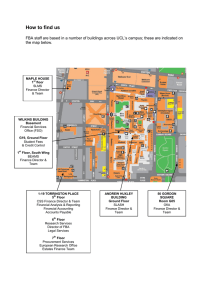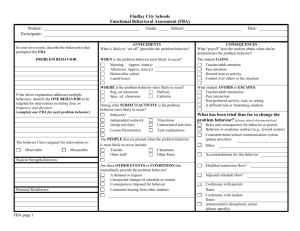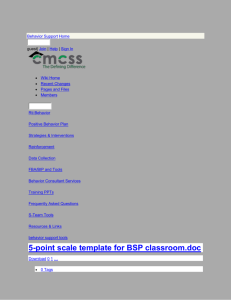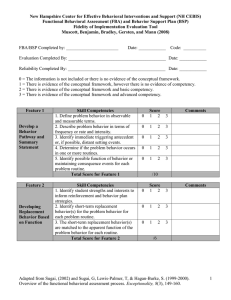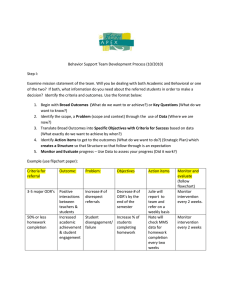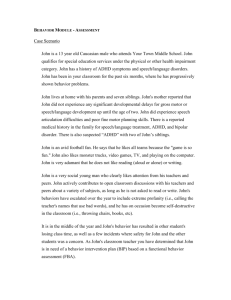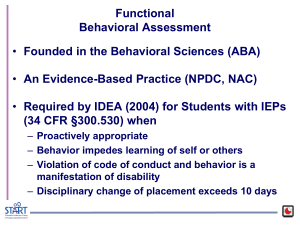10/19/2012 Leading a Team from a Functional Behavioral Assessment
advertisement
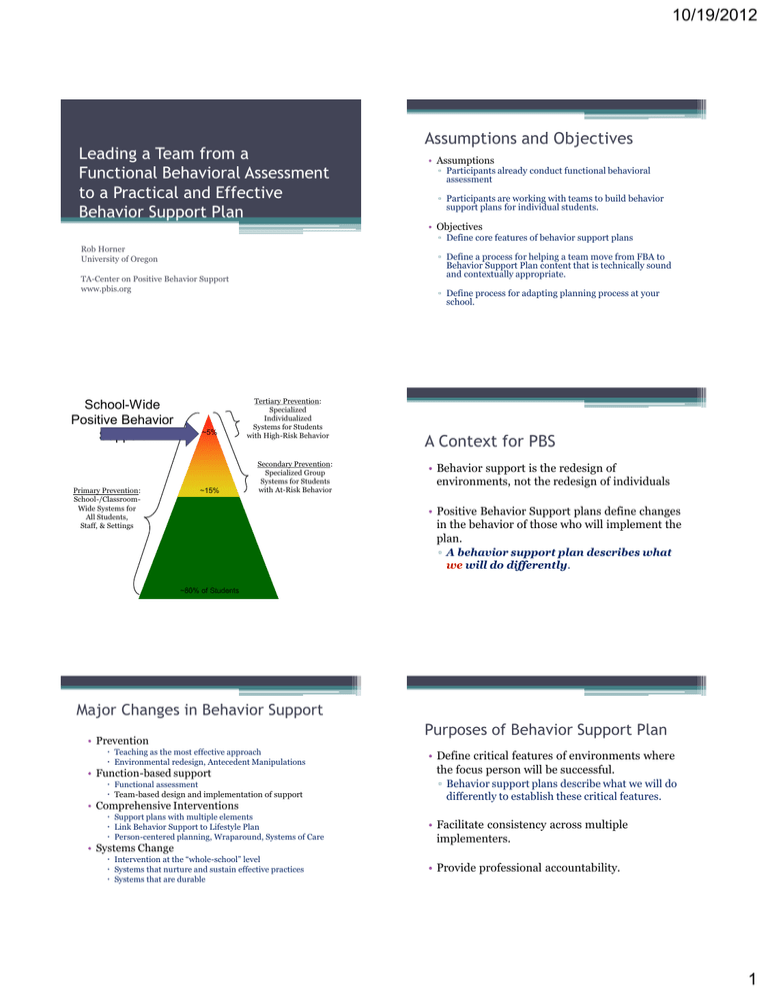
10/19/2012 Leading a Team from a Functional Behavioral Assessment to a Practical and Effective Behavior Support Plan Assumptions and Objectives • Assumptions ▫ Participants already conduct functional behavioral assessment ▫ Participants are working with teams to build behavior support plans for individual students. • Objectives ▫ Define core features of behavior support plans Rob Horner University of Oregon ▫ Define a process for helping a team move from FBA to Behavior Support Plan content that is technically sound and contextually appropriate. TA-Center on Positive Behavior Support www.pbis.org School-Wide Positive Behavior Support Primary Prevention: School-/ClassroomWide Systems for All Students, Staff, & Settings ~5% ~15% ▫ Define process for adapting planning process at your school. Tertiary Prevention: Specialized Individualized Systems for Students with High-Risk Behavior Secondary Prevention: Specialized Group Systems for Students with At-Risk Behavior A Context for PBS • Behavior support is the redesign of environments, not the redesign of individuals • Positive Behavior Support plans define changes in the behavior of those who will implement the plan. ▫ A behavior support plan describes what we will do differently. ~80% of Students Major Changes in Behavior Support • Prevention Teaching as the most effective approach Environmental redesign, Antecedent Manipulations • Function-based support Functional assessment Team-based design and implementation of support • Comprehensive Interventions Support plans with multiple elements Link Behavior Support to Lifestyle Plan Person-centered planning, Wraparound, Systems of Care • Systems Change Intervention at the “whole-school” level Systems that nurture and sustain effective practices Systems that are durable Purposes of Behavior Support Plan • Define critical features of environments where the focus person will be successful. ▫ Behavior support plans describe what we will do differently to establish these critical features. • Facilitate consistency across multiple implementers. • Provide professional accountability. 1 10/19/2012 Behavior Support Elements Problem Behavior Functional Behavioral Assessment *Team *Specialist Functional Assessment • Defined: *Hypothesis statement *Competing Behavior Analysis *Contextual Fit Content of Support Plan * Strengths ▫ Functional behavioral assessment is a process for identifying the events that reliably predict and maintain problem behavior. *Implementation Plan Fidelity of *Technical Adequacy Implementation * Preferences * Lifestyle vision Impact on Behavior and Lifestyle Outcomes of a Functional Behavioral Assessment FBA Summary Statement • Operationally defined problem behavior(s) ▫ By response class Setting Events • Identify routines in which the problem behavior is most and least likely to occur • Define the antecedent events (triggers; setting events) that predict when the problem behavior is most likely Triggering Antecedents 4 2 Allergies In room with Noise and/or many people Problem Behavior 1 Head Hit Maintaining Consequences 3 Avoid noise/people • Define the ONE consequence that contributes most to maintaining the problem behavior in that routine. • Summary Statement of findings. Primary Purposes of Functional Behavioral Assessment Effective Environments • The primary purpose of functional behavioral assessment is to improve the effectiveness and efficiency of behavior support. Behavior support plans built from functional assessment are more effective Didden et al., 1997 Newcomer & Lewis, 2006 Carr et al., 1999 Ingram, Sugai & Lewis-Palmer Ellingson, et al., 2000; Filter (2004) • Create order out of chaos • Problem behaviors are irrelevant ▫ Aversive events are removed ▫ Access to positive events are more common • Problem behaviors are inefficient ▫ Appropriate behavioral alternatives available ▫ Appropriate behavioral alternatives are taught Define contextual information, where, when, with whom, etc. • Problem behaviors are ineffective • Professional accountability • FACTS ▫ Problem behaviors are not rewarded ▫ Desired behavior ARE rewarded 2 10/19/2012 Place Summary Statement in Competing Pathways Model • Use information from interviews and observations to summarize: Setting Events Triggering Antecedents Desired Alternative Typical Consequence Problem Behavior Maintaining Consequences Problem behavior Antecedent Triggers Maintaining Consequences Setting Events Acceptable Alternative Acceptable Alternative: 1.Same consequence 2.Socially acceptable 3.Very efficient Desired Alternative Play with others Setting Events Reprimand during prior class Triggering Antecedents Playground Typical Consequence Peer social interaction Problem Behavior Maintaining Consequences Scream at / threaten others Get access to game or equipment Leading a Team from FBA to BSP • 1. Summarize FBA • 2. Define goals of BSP process: Make problem behavior irrelevant Make problem behavior inefficient Make problem behavior ineffective Do all this in a contextually appropriate manner • 3. Lead discussion to identify options Acceptable Alternative Use “pass” Ask supervisor Ask questions, don’t give solutions Paraphrase, elaborate, integrate Always bring group back to FBA logic Produce multiple ideas (elements) COMPETING PATHWAYS Leading a Team from FBA to BSP • 4. Given an array of possible BSP elements, shift discussion to contextual fit. BEHAVIOR SUPPORT PLANNING Make Problem Behavior Irrelevant ▫ What elements are feasible, acceptable, sustainable?’ ▫ What is the smallest change that will produce the largest effect? Make Problem Behavior Inefficient Make Problem Behavior Ineffective And Positive Behavior More Effective • Contextual Fit: ▫ The extent to which the people who will implement a behavior support plan find the elements of the plan Consistent with their personal values Consistent with the professional skills Consistent with the resources available in the setting Consistent with the available administrative support Examples of Interventions 3 10/19/2012 Outline of a Behavior Support Plan Leading a Team from FBA to BSP • 5. Transform ideas for BSP elements into a formal plan for implementation ▫ Who will do what, when, and how will we know? • Set Up (description, strengths, vision) Outline BSP Template • Assessment (FBA, Person-Centered Plan, Wraparound) Operational Descriptions, Routines, FA Hypotheses • Prevention • Teaching/Education • Consequence Procedures Minimize reward for problem behavior Ensure regular, clear reward for positive behavior Punishers (if needed) • Define safety/emergency procedures (if needed) • Evaluation and Monitoring for Improvement Steps for implementation Examples: Define (a) summary statement (b) prevention, (c) teaching, (d) consequences • Emmit • Eric • Rayette ▫ FACTS ▫ Behavior Support Plan Summary • Invest in building consensus around FBA summary statement. • Recruit strategies that are local, practical, but still consistent with FBA…(Lead don’t tell). Recruit local knowledge • Build efficient plans (the smallest changes that produce the largest effect) • Ensure that the plan includes procedures for getting implementation to occur. • Always include procedures for evaluation ▫ Are we doing what we said we would do? ▫ Is the process having an effect on the student? 4
